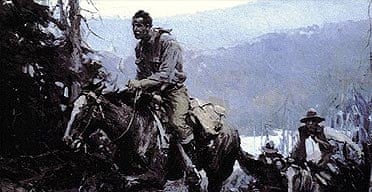Everyone has a picture on the wall with some personal meaning. When the art lover in question is George Bush, however, and he can't stop telling us all his eccentric views about it, our interest is naturally piqued.
Bush, it seems, has a great passion for a 1916 cowboy scene by WHD Koerner that hangs in his office. He loves telling people about its significance to him. According to The Bush Tragedy by Jacob Weisberg, published next month, when governor of Texas, Bush told staff the painting was called A Charge To Keep, a quote from his favourite Methodist hymn by Charles Wesley. He urged them to absorb the moral lesson of this "beautiful painting of a horseman determinedly charging up what appears to be a steep and rough trail. This is us," he said.
Yet a little digging by Weisberg has revealed that the picture in question originally portrayed a bad man, not a good man. It was first used in the Saturday Evening Post in 1916 to illustrate a story about a horse thief, and captioned as a picture of his flight from the law. Only later did it illustrate a story about Methodism.
There are a lot of funny things about this story: the art itself isn't one of them. Bush's favourite painting comes from a tradition of 19th- and early-20th-century art that inspired the later film westerns of John Ford. Koerner's painting is a minor but decent example of the genre.
If you think it's kitsch, look again at those sensitively suggested smoky mountains, that powerful observation of a horse's motion. It is not in itself a shameful thing to love.
Bush's fantastical interpretation of it is another matter. Of course, it's unfair to laugh at someone for doing what everyone does when we look at art - seeing it his way. You bring the art history books, I'll fetch the rope.
Lynne Segal, professor of gender studies
This is such an exhausted cliche of masculinity: the loner on his horse, the heroic, old-fashioned western archetype. It is symptomatic of the fact that Bush lives in a fantasy world, as many American men do, where you can invent a story and place yourself at the centre. You are a hero, not just of your own life, but leading others, too.
Yet this solipsistic vision seems so at odds with the knowledge - a knowledge that you would expect most of us to have today - that others create and shape our world. Instead, this kind of American masculine imagery suggests that you have to be not just the first among equals but heading the pack, leading the way forward.
Darian Leader, psychoanalyst
The painting itself is fairly dull. What is interesting is that Bush has invested a great deal in it, and seems to use it as a symbol of what he sees as his own mission. He interprets it as the story of missionaries spreading the word of truth and freedom, an impulse that informed the invasion of Iraq, when in fact it is a depiction of thieves on the run from the law. It's a good example of repression: when we want to avoid an unpleasant truth, it has a habit of returning. There is a wonderful complement to this in a speech Tony Blair gave to troops in Iraq, during which he referred to "weapons of mass distraction". This painting is Bush's Freudian slip.
It also seems to illustrate a legacy being passed from father to son. It is almost impossible to understand Bush's aspirations without thinking of what he saw as the unfinished business of his father. This painting suggests that if you want to understand Bush, you need to understand his father, and that's a psychological truth that has an impact on world politics.
Joanna Bourke, military historian
There is a military feel to this painting. The men are armed and obviously fleeing, but the enemy is invisible, hidden in a huge expanse of rough, tough landscape. Bush clearly identifies with the main character in the painting: he is the leader of men, tough and masculine, travelling light with a magnificent animal between his thighs.
The war depicted here is partly against nature. It represents the taming of the great frontier. But there's also a clear link to the American civil war, and to the battle against the wild Indians: the traditional American goodies and baddies. For Bush, the foreign baddies are terrorists, both abroad and within. Of course, the irony is that, in the painting, the men on horseback are the bandits. Bush is interpreting this as a utopian scene, as bandits often do, when in fact what is depicted is simple masculine criminality.
Derek Draper, psychotherapist and ex-Labour spin doctor
Bush's mistaken enthusiasm suggests several psychological interpretations. The first will most readily appeal to committed Bush-haters: it is evidence of his tendency to misread situations and confuse right with wrong. A more subtle insight might involve imagining Bush's inner world: for so long inhabited by the demons of drink, drugs and failure. His mind might resist a too-close-to-home image of a troubled man fleeing for his life and have to see instead the strong, heroic adventurer he has convinced himself he has become.
Most revealing, though, is the simple fact that a healthy mind would look at this image and not be certain what it depicted. Bush, though, as he once told Senator Joe Biden, doesn't "do nuance". Instead he invariably replaces "not-knowing" with prejudiced certainty. A foolish psychological mindset when it comes to art or life; a catastrophic one in politics.
